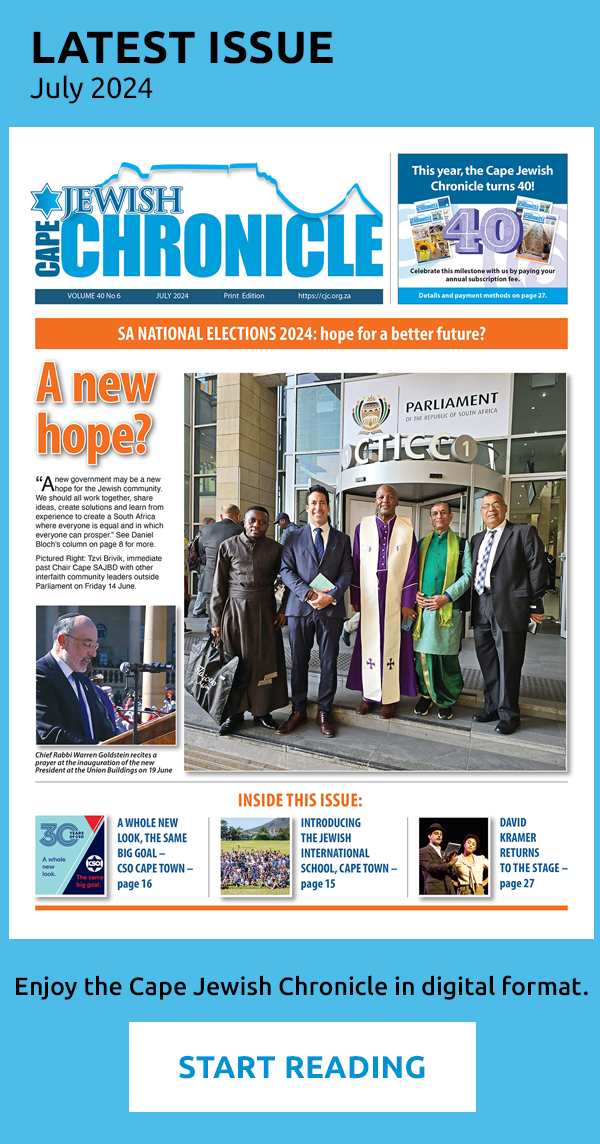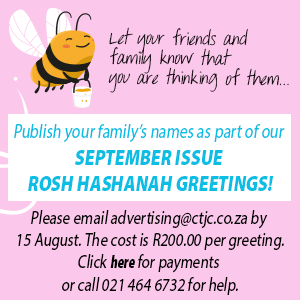By Gwynne Robins, Senior Researcher, Cape SAJBD
Ladismith in the Klein Karoo is a farming community that grows flowers, grapes and deciduous fruit, and produces mutton, milk, cheese and wine.
Like Ladysmith in KZN, it was named after Sir Harry Smith’s much-loved wife Juana María, whom he married when she was 14. In gratitude she presented the village with £10 and a bible.
A visitor to the Ladismith Museum, formerly a church, wrote on 18 December 2019 that, “it is a pity that in spite of there having been a large Jewish population in this town at one stage, not a mention is made of this. Instead we are confronted with photographs and histories of Boer farmers. This is typical of mainly Afrikaans-speaking dorps.” This article hopes to remedy this.
Another website snidely remarks that the Klein Karoo benefited from the ostrich feather boom period at the beginning of the previous century, and this “opulence” attracted several Jewish families from the Baltic states, and that at one stage in the early 1900s there were about thirty Jewish families living there. It does not indicate that much of the ‘opulence’ resulted from the energy, hard work and entrepreneurship of those poor Jewish pedlars from the Baltics who saw opportunities and developed the economy and the ostrich industry.
Oudtshoorn was the centre of the ostrich industry. Some Jewish immigrants on the way there, stopped off and remained in Ladismith, 100km away. Already in 1880 Abraham Nurick from Shavel, a shopkeeper; Moses Hoffland, an ostrich feather buyer from Vilna; and Sydney Adler, a bookkeeper, had settled there. One of the first families to settle there was the Gordon family from Neustad-Sugind from where the legendary Sammy Marks originated, and where this writer’s great-grandfather had been the cantor. Mayer Gordon owned a liquor store, David Gordon was a feather buyer and Solomon Gordon was a general dealer.
An undated architectural survey of Cross Street mentions that Solomon Gordon paid rates for the Dinnes Hotel Annexe in 1894 where his family and shop were located. (The hotel was later operated by the Greens, Wainsteins and the brothers Oberstein). It goes on to say that “old Solly and his brother were well-known characters”. (‘Old Solly’ was 64 when he died). Solly’s daughter Selina was the first Jewish woman to graduate from the University of Cape Town in 1900, and the first Jewish person to get married in Ladismith, in 1905. In 1891 the 17-year old Max Rose from Shavel arrived in Ladismith, having spent a year in Oudtshoorn as a smous, and opened a shop with his landsleit Isaac Nurick at Zoar, in the Ladismith district. Nathan Broido, a speculator settled there in 1896 — by 1903 he had been elected onto the Municipal Council and the School committee.
Solomon Gordon’s tombstone states that he was the founder and leader of the Ladismith Hebrew Congregation. By 1904 there were 71 Jews living in Ladismith. Although the congregation was only formed in 1906, they had employed Rev Eliyahu Walt four years earlier and were advertising for a reader, mohel, shochet and teacher for £12 a month, in 1909 and 1911.
In 1913 they built a synagogue and a Hebrew school with 30 pupils. The synagogue was designed in a Lithuanian style with round-headed lancet windows, a colonnaded portico on the side and a pressed steel ceiling adorned with an enamel Star of David. To celebrate, a banquet was held in the Nurick home, preceded by a minchah service conducted by Solomon Gordon, and the key presented to Nurick by Broido. The president of the congregation FS Mann, an ostrich feather magnate who paid for the synagogue from his own private funds, was overseas at the time. Mann was to be elected Mayor of Ladismith, a member of the Ladismith Provincial Council and to serve on the executive of the Cape Provincial Council.
The Afrikaans poet CJ Langenhoven, who lived in Oudtshoorn and Ladismith, was friendly with Mann and Rose. Langenhoven’s secretary, executrix and lover was Sarah Goldblatt, whose father David, was a Yiddish journalist who had worked with Morris Alexander to get Yiddish recognised as a European language so that Eastern European Jews could immigrate to the Cape. Langenhoven’s daughter Engela lived in Ladismith. Alexander later formed the Jewish Board of Deputies.
The congregation contributed to the Jewish National Fund and the Shekel Fund in 1909; and the Ladismith Zionist Society started in 1913 with Harry Lipschitz as its first chairman, followed by the Ladismith Young Zionist Society in 1919, with Nathan Mann as its first president.
The Ladismith Jewish Cemetery with 25 graves was part of the municipal cemetery and is currently cared for by the municipality.
Rose was to become known as the Ostrich King of South Africa. He started to study the breeding and eating habits of ostriches and in 1906 bought the farm Weltevreden in the Ladismith district for £18 000.He sold it seven years later for £200 000.
Before the First World War ostrich feathers were outranked only by gold, diamonds and wool among South African exports. In 1911 there were 30 Jewish families in Ladismith — and with the exception of two shopkeepers and two tailors, they were all feather merchants. This boom peaked in 1913, after which it collapsed, with 80% of the ostrich farmers bankrupted. Rose, like everyone else, lost everything in the crash, but he kept his ostriches and fed them even when he didn’t have enough to eat himself. A second, short-lived and bigger boom started after the war. In 1917 the government appointed him to the Ostrich Feather Commission. Things got better in the 1940s with an increase in feather prices and a new demand for ostrich leather and meat, by which time Rose owned one-fifth of the birds in South Africa.
The failure of the ostrich industry and the economic depression in the 1920s resulted in the Ladismith Jewish population dropping by half by 1936. In addition, there was an increase in antisemitism in the country with Dr Donges, the National Party Candidate for Ladismith in 1927 campaigning on ‘the Jewish question’, the Communist Jews in trade unions, and criticising the government for allowing in too many Jews and letting them change their names. In nearby VanWyksdorp, DF Malan was thanked for his stand on the Jewish problem. Although there was no antisemitism in Ladismith, and the Greyshirts were refused permission to hold a meeting in the Ladismith Town Hall, many Jewish businesses and factories in Oudtshoorn were torched between 1940 and 1947.
With the decline of numbers, the Hebrew school was sold to the Lutheran school in 1960, the synagogue was sold in 1971 and is now used as a badminton court. The bimah and benches went to George and Beaufort West, and one Sefer Torah was sent to Beaufort West, one to Caledon and one to the Country Communities rabbi.
By 1980 there were only five Jews remaining.
The Cape SAJBD’s Country Communities subcommittee looks after the cemeteries of the defunct country communities. For queries, contact danielb@ctjc.co.za.
Much of the information in this article comes from Jewish Life in the South African Country Communities, Volume III, researched by the South African Friends of Beth Hatefutsoth.

Cape SA Jewish Board of Deputies website: www.capesajbd.org, Instagram, and Facebook page.
• Published in the PDF edition of the September 2021 issue – Download here.
• Sign up for our newsletter and never miss another issue!
• Please support the Cape Jewish Chronicle with a voluntary Subscription. For payment info click here.
• Visit our Portal to the Jewish Community to see a list of all the Jewish organisations in Cape Town with links to their websites.
Follow the Chronicle: Facebook | Instagram | Twitter | LinkedIn










